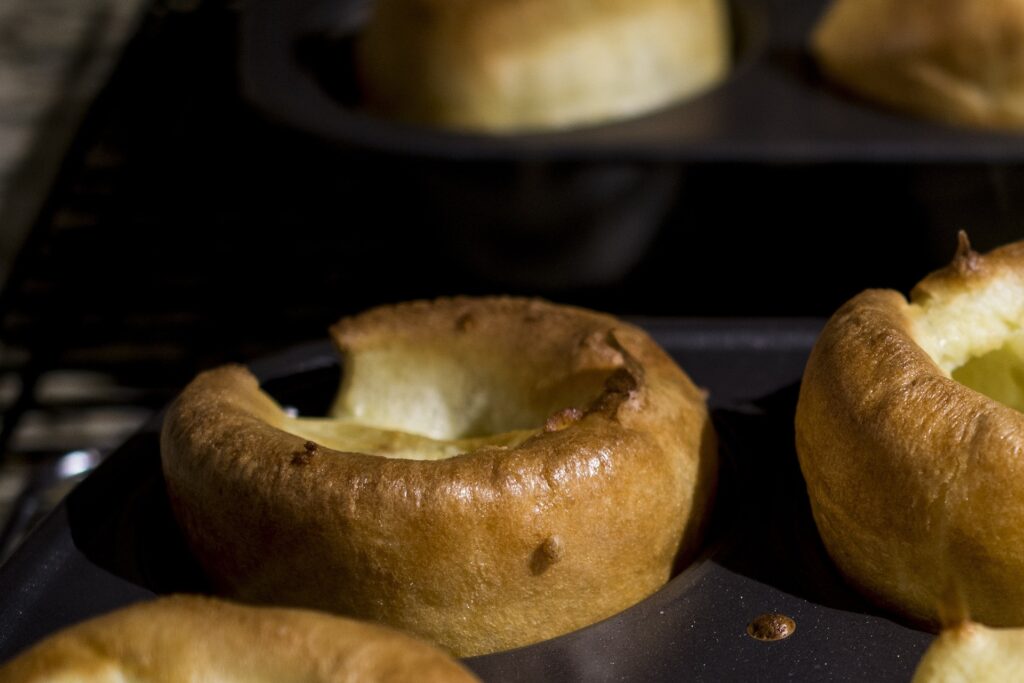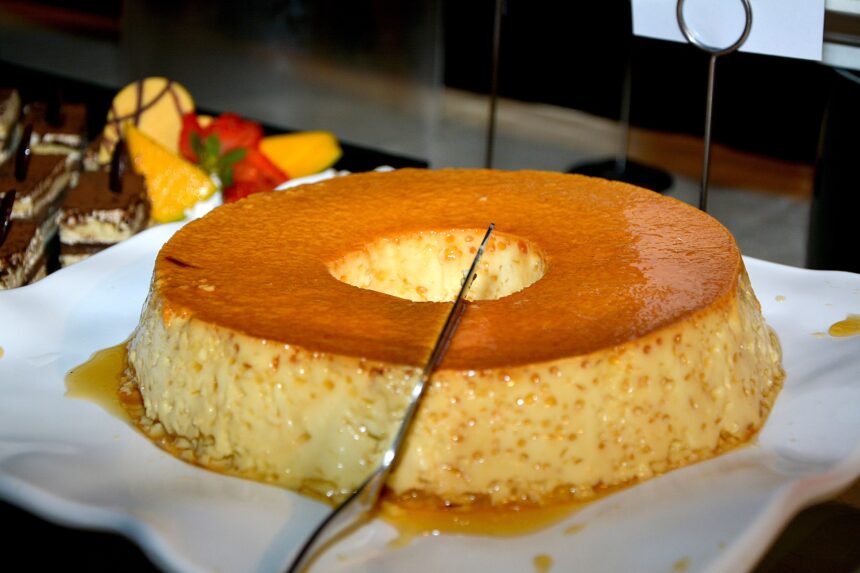Yorkshire pudding Recipe—a name that conjures up the comforting aromas of a Sunday roast and the warmth of family gatherings. This quintessential British dish is more than just a side; it’s a beloved staple that adds an element of nostalgia and joy to any meal. Let’s explore the fascinating world of Yorkshire pudding, from its rich history to the perfect recipe that will leave your guests asking for more.
What is Yorkshire Pudding?
Yorkshire pudding is a light, airy pastry made from a simple batter of flour, eggs, and milk, often flavoured with a touch of salt. Traditionally served alongside roast beef, it serves as both a side and a vehicle for gravy, soaking up all those delicious juices. The contrast of its crispy exterior and fluffy interior creates a delightful texture that complements the richness of the main dish perfectly.
A Brief History of Yorkshire Pudding
The origins of Yorkshire pudding date back to the 18th century in England, with the earliest written recipe appearing in a book titled “The Whole Duty of a Woman” in 1737. Originally called “dripping pudding,” it was made from the fat drippings of meat roasted over an open flame. The dish allowed families to stretch their meals further, utilizing every part of the meat and avoiding waste. By the 19th century, Yorkshire pudding had evolved into a staple of Sunday dinners, especially in northern England, where it was often served before the main course to fill hungry bellies.
Why Yorkshire Pudding?
Adding Yorkshire pudding to your meal brings not only a touch of tradition but also a versatile culinary option. It’s an excellent way to showcase your cooking skills while delighting your guests. Plus, there’s something undeniably satisfying about watching these golden puffs rise in the oven. They’re a crowd-pleaser that can turn an ordinary meal into an extraordinary one, making every occasion feel special.
Key Ingredients for Yorkshire Pudding Recipe
Flour
The foundation of Yorkshire pudding Recipe is its flour. All-purpose flour is the most commonly used type, providing the right balance of strength and texture. For a gluten-free option, consider using a gluten-free flour blend, but be aware that this may alter the pudding’s texture slightly.
Eggs
Eggs are crucial for providing structure and stability to the batter. Fresh, room temperature eggs yield the best results, as they whip up easily and help create a light, airy texture. For a vegan option, you can substitute eggs with flaxseed meal mixed with water or commercial egg replacers.
Milk
Whole milk is preferred for its creamy richness, but you can experiment with different dairy or non-dairy options. Semi-skimmed milk will work, but the pudding may be less rich. For lactose-free diets, consider almond or oat milk as alternatives.
Fat
Traditionally, Yorkshire pudding is made with beef drippings, which impart a deep, savoury flavor. However, vegetable oil, lard, or even butter can be used. The key is to ensure the fat is hot when the batter is added to achieve that characteristic puffiness.
Essential Tools for Making Yorkshire Pudding
- Mixing Bowl: A large mixing bowl is essential for combining ingredients.
- Whisk: Use a whisk to ensure your batter is smooth and well-aerated.
- Muffin Tin or Roasting Tray: The vessel in which your puddings will rise.
- Measuring Cups and Spoons: Accurate measurements are vital for the perfect pudding.
- Ladle: For pouring the batter into the hot oil without splashing.
Step-by-Step Yorkshire Pudding Recipe
Preparing the Batter
- In a mixing bowl, combine 1 cup of all-purpose flour and a pinch of salt.
- In another bowl, whisk together 1 cup of milk and 3 large eggs until well blended and slightly frothy. This introduces air, which helps with rising.
- Gradually add the wet mixture to the flour, whisking continuously until you have a smooth batter. Let it rest for at least 30 minutes at room temperature to help it thicken.
Prepping the Pan
- Preheat your oven to 425°F (220°C).
- Add about 1 tablespoon of fat to each compartment of your muffin tin or a roasting tray. Make sure to cover the bottom completely.
- Place the tin in the oven for 5-10 minutes, until the fat is smoking hot. This step is crucial for achieving that perfect rise.
Baking the Pudding
- Carefully remove the hot tin from the oven.
- Quickly and evenly pour the batter into each compartment, filling them about halfway. Be cautious of splashing hot fat!
- Return the tin to the oven and bake for 20-25 minutes or until the puddings are puffed up and golden brown. Avoid opening the oven door during baking, as the sudden drop in temperature can cause them to deflate.
Common Mistakes to Avoid
- Under-mixing: Make sure your batter is smooth to allow for proper aeration.
- Cold batter: Using ingredients at room temperature helps with rising.
- Overcrowding the pan: Leave space between each pudding to allow them to rise without sticking together.
- Opening the oven door: This can cause the puddings to collapse. Patience is key!
Serving Suggestions
Traditionally served with roast beef, Yorkshire pudding Recipe can also accompany a variety of dishes. Here are some suggestions:
- Roast Chicken: The light texture of Yorkshire pudding balances the richness of the chicken.
- Vegetarian Gravy: A mushroom or onion gravy can enhance the flavor and make it a satisfying vegetarian option.
- Savory Sauces: Try serving with a garlic butter sauce or a rich cheese sauce for a twist.
Variations of Yorkshire Pudding
Toad in the Hole
This classic variation features sausages baked into the batter, creating a hearty one-dish meal. Simply place the sausages in the hot fat before adding the batter.
Stuffed Yorkshire Puddings
Consider stuffing them with a mixture of sautéed vegetables, cheese, or even pulled pork for a unique take.
Mini Yorkshire Puddings
Create bite-sized versions for a fun appetiser. These are perfect for parties and can be filled with various toppings.

Storing Leftovers
If you have any leftovers, store them in an airtight container in the fridge. To reheat, place them back in a hot oven for a few minutes to regain their crispiness. Avoid microwaving, as this can make them soggy.
Pairing Yorkshire Pudding with Other Dishes
Yorkshire pudding can enhance a variety of meals. Here are some great pairings:
- Roast Lamb: The rich flavours of lamb complement the buttery goodness of Yorkshire pudding.
- Vegetable Stew: A hearty vegetable stew makes a delightful vegetarian option.
- Beef Wellington: For an extravagant meal, serve Yorkshire pudding as a side to this classic dish.
Yorkshire Pudding: A Global Perspective
While deeply rooted in British tradition, Yorkshire pudding has found its way into kitchens worldwide. Chefs across the globe have embraced its versatility, incorporating it into diverse cuisines. In the U.S., you might find it served alongside a Thanksgiving turkey, showcasing its adaptability.
The Best Drinks to Accompany Yorkshire Pudding
To enhance your dining experience, consider these beverage pairings:
- Robust Red Wine: A Cabernet Sauvignon or a Merlot can elevate the flavors of your meal.
- English Ale: A classic pint of ale complements the richness of Yorkshire pudding beautifully.
- Sparkling Water: If you prefer non-alcoholic options, sparkling water with a slice of lemon refreshes the palate.
Conclusion
Yorkshire pudding Recipe is more than just a side dish; it’s a symbol of comfort, tradition, and culinary creativity. Whether you’re enjoying it with a classic Sunday roast or experimenting with modern variations, this dish has something to offer everyone. With its delightful texture and rich flavour, Yorkshire pudding truly deserves a place at your table.
FAQs
1. Can I make Yorkshire pudding in advance?
While they are best fresh, you can prepare the batter ahead of time and bake them just before serving for the best texture.
2. What can I use if I don’t have a muffin tin?
A roasting tray works well! Just ensure you leave enough space between puddings to allow for proper rising.
3. Can I use whole wheat flour instead of all-purpose flour?
Yes, but it may alter the texture slightly, making them denser. Consider blending it with all-purpose flour for better results.
4. How do I know when my Yorkshire puddings are done?
They should be puffed up and golden brown. A skewer inserted should come out clean, indicating they are fully cooked.
5. What other dishes can I serve with Yorkshire pudding?
It pairs well with a variety of meats, vegetables, and gravies, making it a versatile side dish. Think roast meats, hearty stews, or rich sauces for an ideal combination.







